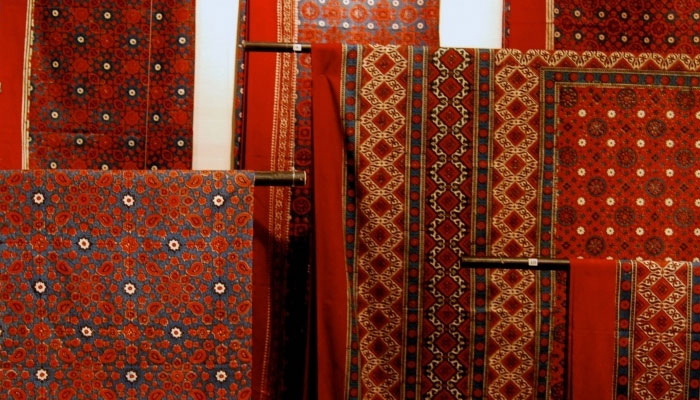Ajrak-makers technologise trade to keep traditions alive
HYDERABAD: Imran Soomro, whose ajrak workshop at Bhit Shah’s artisan town, Matiari district, was on the verge of closing down lately is back in business and even expanding, only because he had the courage to go 'new school' to keep the old alive.
He claims digital transformation has enabled him to reach the major markets through changing supply mechanisms and earning little more compared to traditional practice.
For this, he said they had initially hired new skilled and interested young workers for strengthening the capacity to meet the growing demand.
“We have developed online networking with the markets,” he said.
There are around 20 small and larger ajrak workshops in the town in which more than 500 artisans work on daily wages, earning Rs500-1000 daily, depending on their skills and work quality.
“Now you can see the modernisation in designs as per local as well as international demand and we are working strictly to adopt the same,” Imran said.
“Previously, there were a few wooden print block makers in Bhit Shah artisan town, having old designs, which at
this level of demand are not fully acceptable. Thus we buy new blocks with innovative designs from Punjab’s Jhang town,” he said.
“Wooden print blocks in Punjab are cheaply available at Rs3000 each compared to those available at Bhit Shah block-makers at Rs5000 each.”
In fact these wooden blocks in Punjab were made by machines with various designs, which were available at low prices, he said. “They can make such new blocks with various designs, especially with images of wildlife and marine species like fish, crocodile, whale, birds, butterflies, and reptiles,” Imran added.
Imran Soomro is the son of an experienced Ustad Hajan Soomro, who claims to have inherited and started this work as a child.
Information gathered from artisans shows that hardly a few years back many leading artisans closed their old workshops because of a decline in this creative handmade work and a large number of skilled workforce was let go.
The artisans had faced problems after the emergence of global coronavirus pandemic and the subsequent lockdowns forced them to stay idle at homes for several months.
But now not only the world market has opened, there is a demand for supplying innovative designs in dresses and shawls with ajrak prints.
“We have to give orders to block print makers to design such animals and birds, which we follow here,” he said.
The ajrak artisans have different categories like young workers, who need further training for washing the printed clothes at canals, watercourse, or ponds and using printing blocks properly, while others are more experienced.
Ajrak manufacturing workshops managers believe there is no support by the government authorities at any level. For example, they need fine quality earth, mud and water stream for this industry but they have to travel long distances, bearing the cost of transport for the purpose.
Gul Muhammad Soomro, 70, the most experienced artisan at the workshop, said, “Following my elders I learned this skill during my childhood and have been continuously working to earn a living and keep myself engaged”.
Shafeeq Soomro, another workshop owner from Matiari city, sharing ups and downs in this industry, said the city had 25 workshops some years back and now “we have 12 workshops only, offering a source of income to the skilled workforce”.
In his understanding they are facing problems finding fine quality earth, mud, and fresh water stream for this product near their workshops.
“These are hard to find these days because of depletion of land and water streams. Due to this, we have to travel long distances, bearing the cost of transport for the purpose, Shafeeq said. .
Shafeeq said they have donkey carts for bringing earth and mud from the River Indus stream near Matiari city and washing the ajrak shawls there.
He has hired 30 skilled workers at his workshop to produce more items as per demand.
He said after growing demand for this product some young artisans have joined these ajrak workshops in different cities to learn the skills.
But elderly artisans said this work needed attention and consistency to adopt new skills. “Because each process has it’s unique needs, which the young artisans have to follow,” a senior artisan said.
About natural dye, the artisans said due to unavailability of old color products like indigo they had adopted new ones to continue the work.
In this regard, they use kesuphool (butea monosperma), babul tree canopies, eucalyptus leaves and other items to make dye for the new products, especially women's dresses.
The artisans justify that since they have innovated from making blue shawl to the dresses, especially for women, these items are useful for colours.
The ajrak makers face a long struggle to sell their products at larger scale. Now they have easy access to the urban entrepreneurs, who have their own popular brands with tags.
In this situation the original producers (artisans) seem incapable to demand for copy rights or share of the value of the products. Because they have to sell their products at a larger scale which previously was not possible for them.
They have developed linkages to these companies for the sale. That is why they are hiring workers to produce maximum products to meet the demand on time.
-
 Rachel McAdams Becomes Object Of Jokes At Hollywood Star Of Fame Event
Rachel McAdams Becomes Object Of Jokes At Hollywood Star Of Fame Event -
 South Korea's Ex-PM Han Duck-soo Jailed For 23 Years Over Martial Law Crises
South Korea's Ex-PM Han Duck-soo Jailed For 23 Years Over Martial Law Crises -
 Global Markets On Edge Over Greenland Dispute: Is US Economic Leadership At Risk?
Global Markets On Edge Over Greenland Dispute: Is US Economic Leadership At Risk? -
 King, Queen Visit Deadly Train Crash Site
King, Queen Visit Deadly Train Crash Site -
 Oxford Research Warns ChatGPT Reflects Western Worldviews
Oxford Research Warns ChatGPT Reflects Western Worldviews -
 UK Inflation Unexpectedly Rises To 3.4% In December, The First Increase In Five Months
UK Inflation Unexpectedly Rises To 3.4% In December, The First Increase In Five Months -
 Meghan Markle Set To Take Big Decision On Returning To UK For Invictus Games
Meghan Markle Set To Take Big Decision On Returning To UK For Invictus Games -
 Prince Harry To Leave Britain One Day Earlier Than Expected For THIS Reason
Prince Harry To Leave Britain One Day Earlier Than Expected For THIS Reason -
 The Way You Consume Sugar Could Be Affecting Your Health
The Way You Consume Sugar Could Be Affecting Your Health -
 Brooklyn Beckham Gets Backing From Vanessa Marcil Amid Feud With Parents
Brooklyn Beckham Gets Backing From Vanessa Marcil Amid Feud With Parents -
 OpenAI Uses AI To Detect Under 18 Users On ChatGPT
OpenAI Uses AI To Detect Under 18 Users On ChatGPT -
 Philippines To Lift Ban On Grok AI After Musk's Platform Commits To Fix Safety Concerns
Philippines To Lift Ban On Grok AI After Musk's Platform Commits To Fix Safety Concerns -
 Trump Vows ‘no Going Back’ On Greenland Ahead Of Davos Visit
Trump Vows ‘no Going Back’ On Greenland Ahead Of Davos Visit -
 Alexander Skarsgard Breaks Silence On Rumors He Is Bisexual
Alexander Skarsgard Breaks Silence On Rumors He Is Bisexual -
 King Charles Faces Rift With Prince William Over Prince Harry’s Invictus Games
King Charles Faces Rift With Prince William Over Prince Harry’s Invictus Games -
 Elon Musk’s Critique On ChatGPT Safety Draws Sharp Response From Sam Altman
Elon Musk’s Critique On ChatGPT Safety Draws Sharp Response From Sam Altman




